What happens when a nationally celebrated animal welfare organization fails to deliver on its promises? The partnership between Best Friends Animal Society (BFAS) and Indianapolis Animal Care Services (IACS), once heralded as a transformative collaboration to achieve no-kill status, has instead unraveled into a cautionary tale of unmet expectations and operational decline. Despite embedding a BFAS’ Interim Manager throughout 2024, IACS' performance metrics have plummeted to historic lows, raising serious questions about the effectiveness of BFAS' strategies and their broader impact on animal welfare.
A Decline in Service Amid Lofty Promises
BFAS entered into a formal agreement with IACS in early 2024, promising to elevate the shelter’s live-release rate to the no-kill benchmark of 90% while improving operations and community engagement. However, data from IACS paints a starkly different picture. The shelter recorded its lowest animal intake on record—a 46% drop compared to 2019—far exceeding the national average decline of 11.3%.
This dramatic reduction aligns with BFAS' controversial Managed Intake policy, which is intended to limit shelter admissions to match capacity. However, this policy often leaves large numbers of vulnerable animals to fend for themselves on the street. An explosion of stray animals on the street could explain why response times for animal control calls ballooned to six days by the end of 2024, a tenfold increase from 2019, further straining community trust in IACS’ ability to meet its obligations.
These operational failures extend beyond intake and response times. Enforcement activities have plummeted, with citations and summons issued by Animal Control Officers falling to their lowest levels since 2019. The foster program, once a cornerstone of IACS’ lifesaving efforts, has languished, with only 140 animals in foster care at any given time in 2024—down from 477 in 2019. These trends suggest systemic dysfunction rather than progress.
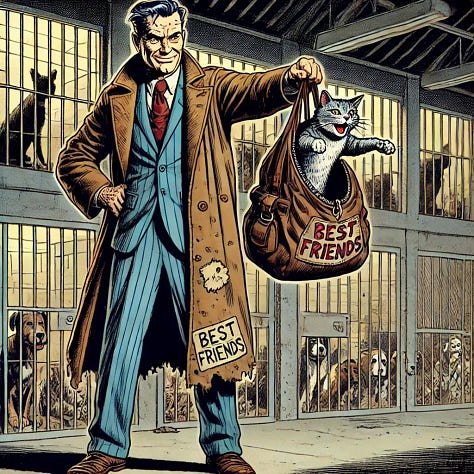
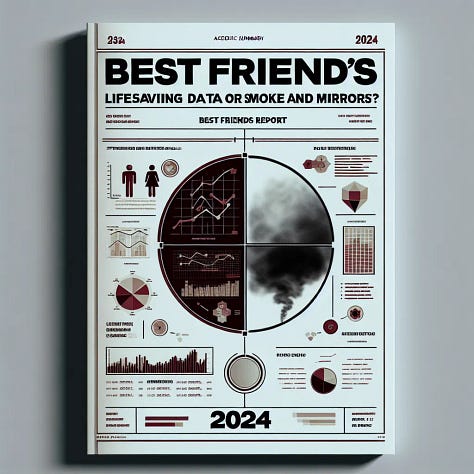
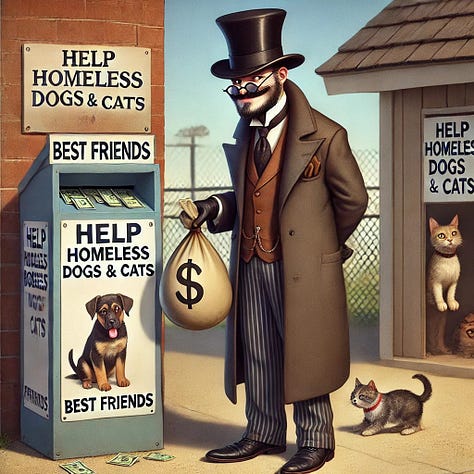
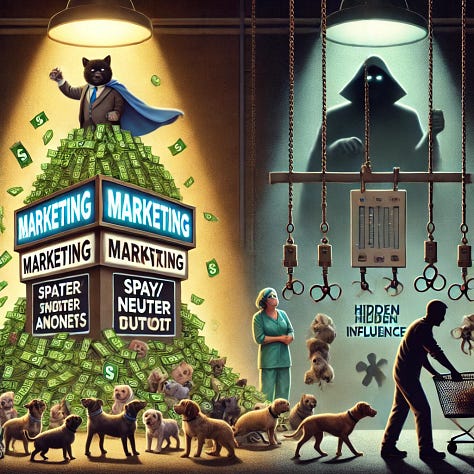
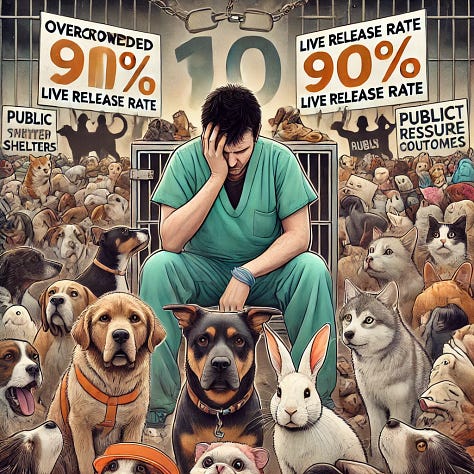

The Reality Behind the Numbers
While BFAS touts its "Save Them All" campaign as a beacon of hope for shelter animals nationwide, critics argue that its focus on optics over substance is undermining its mission. The slight improvement in IACS’ live-release rate—from 84.89% in 2023 to 86.68% in 2024—masks deeper issues. Animals are spending longer periods in the shelter, with average lengths of stay reaching their highest levels since data collection began.
Moreover, the partnership has failed to address critical gaps in transparency and accountability. Megan McNames, a former IACS employee and data analyst, highlighted inconsistencies in public reporting that hinder meaningful evaluation of the shelter's performance. Missing data on intake requests versus actual intakes further obscures the true state of operations.
A Pattern of Controversy
The Indianapolis debacle is not an isolated incident for BFAS. Animal Politics has explored recurring concerns about unmet expectations, controversial policies, and operational challenges involving BFAS in communities from Los Angeles to Danville, VA (articles linked below*).
While BFAS' no-kill mission is laudable, its execution often falls short, leaving shelters and communities grappling with unresolved challenges. These cases underscore the need for greater transparency, accountability, and locally tailored solutions in animal welfare partnerships.
Critics argue that BFAS prioritizes marketing its no-kill agenda over implementing sustainable solutions. In Indianapolis, volunteers and staff have voiced concerns about decisions made under BFAS’ guidance. Reports emerged of reduced feeding portions for dogs and neglect of cat programs, leading some to question whether BFAS' cost-cutting measures are compromising animal welfare.
The Broader Implications
BFAS’ approach raises ethical questions about the no-kill movement itself. While reducing euthanasia is a noble goal, critics contend that BFAS’ methods—such as warehousing animals for extended periods and limiting intakes—often come at the expense of animal well-being and public safety. The organization’s push for high live-release rates has been linked to inadequate screening processes that have resulted in dangerous animals being adopted into unprepared homes.
In Indianapolis, these policies appear to have exacerbated existing challenges rather than alleviating them. With IACS set to become an independent agency in 2025 and receive increased funding under Mayor Joe Hogsett’s proposed budget, there is hope for reform. However, the legacy of BFAS’ involvement serves as a stark reminder of the risks inherent in outsourcing leadership to external organizations without robust oversight.
A Call for Accountability
As communities across the nation grapple with how best to achieve humane outcomes for shelter animals, Indianapolis offers a sobering case study. The partnership with BFAS was intended to be a lifeline for IACS but has instead left it floundering under the weight of unfulfilled promises and operational missteps.
It is time for local governments and animal welfare organizations to demand greater accountability from groups like BFAS. The lives of countless animals—and the trust of the communities they serve—depend on it.
*Dear Subscribers,
Over the past year, I have explored the challenges and controversies surrounding Best Friends Animal Society (BFAS) in their efforts to implement their no-kill mission across various communities. While their goal of saving animals is commendable, my research has identified recurring operational challenges and unintended consequences in some of their partnerships. These issues raise important questions about transparency, accountability, and the sustainability of their approaches.
For those new to this conversation or seeking a deeper understanding, I’ve compiled a list of my articles below. These pieces critically examine BFAS’s strategies and their impact on communities across the country. They also highlight areas where improvements could strengthen animal welfare outcomes for all stakeholders.
I encourage you to read through these articles and share your thoughts. Together, we can foster a meaningful dialogue to drive positive change for animals and communities alike.
*Previous Articles Regarding Best Friends Animal Society
Best Friends’ Los Angeles Campaign: A Cloak of Collaboration, a Core of Control
Best Friends or Big Trouble? The Irony of Julie Castle's Critique of LA Animal Services
Best Friends' Latest Play in LA: Is the Cat Out of the Bag?
Ghost Animals: How Best Friends' Shelter Policies Fail the Most Vulnerable
No-Kill or No Accountability? A Critique of Best Friends' 2024 National Impact Report
Best Friends’ 2024 Report: Lifesaving Data or Smoke and Mirrors?
Best Friends' Year-End Appeal Raises Questions About Transparency and Accountability
Easy Wins or Easy Marks? Best Friends' Controversial Shift in Markets
Best Friends' No-Kill Initiative: A Power Play with Local Consequences
Best Friends’ Playbook: Manipulation Disguised as Advocacy
The Battle for Animal Welfare: Interview with Best Friends' Worst Enemy
Best Friends' Marketing Empire: The Gap Between Image and Impact
LA's Dangerous Gamble: Are Homeless Animals Pawns in a Numbers Game?
Best Friends or Broken Trust? The No-Kill Movement Faces a Crisis in Los Angeles
Ed Boks is a former Executive Director of the New York City, City of Los Angeles, and Maricopa County Animal Care & Control Departments, and a former Board Director of the National Animal Control Association. His work has been published in the LA Times, New York Times, Newsweek, Real Clear Policy, Sentient Media, and now on Animal Politics with Ed Boks.




These managed intake policies ALWAYS come at the expense of the animal's well-being. It's unacceptable and is adding the burden to the smaller rescues who are already overwhelmed and have no money. Or even worse, the public, who many times let the animal end up in horrific situations such as heing dumped in the desert, given to homeless drug addicts to use to get money for drugs, and on and on. When will animal welfare leaders actually start caring about animals?
No-kill is a commendable goal, but it will NEVER be achieved without robust, ongoing spay and neuter programs. So why have all the Big Boys, the well-funded organizations and foundations, stopped promoting and supporting spay and neuter? What's in it for them to have more animals on the streets, more animals in shelters, and more animals being euthanized in shelters?
I visited BFAS in 2018 and was surprised that there were no tours or volunteer opportunities in their (previously) much-touted spay and neuter clinic. When I asked for a tour, the response I received made me feel that I'd crossed a line. When I finally received an answer a day or two later, and visited the clinic (on a weekday), I was surprised that nobody was there. No people, no animals. It was a beautiful, well-equipped facility that was eerily silent. No animals were being served, despite the fact that the need for affordable spaying and neutering in their own community is huge.
Going on their website just now, I see that their spay and neuter clinic is "temporarily closed." What a terrible waste.